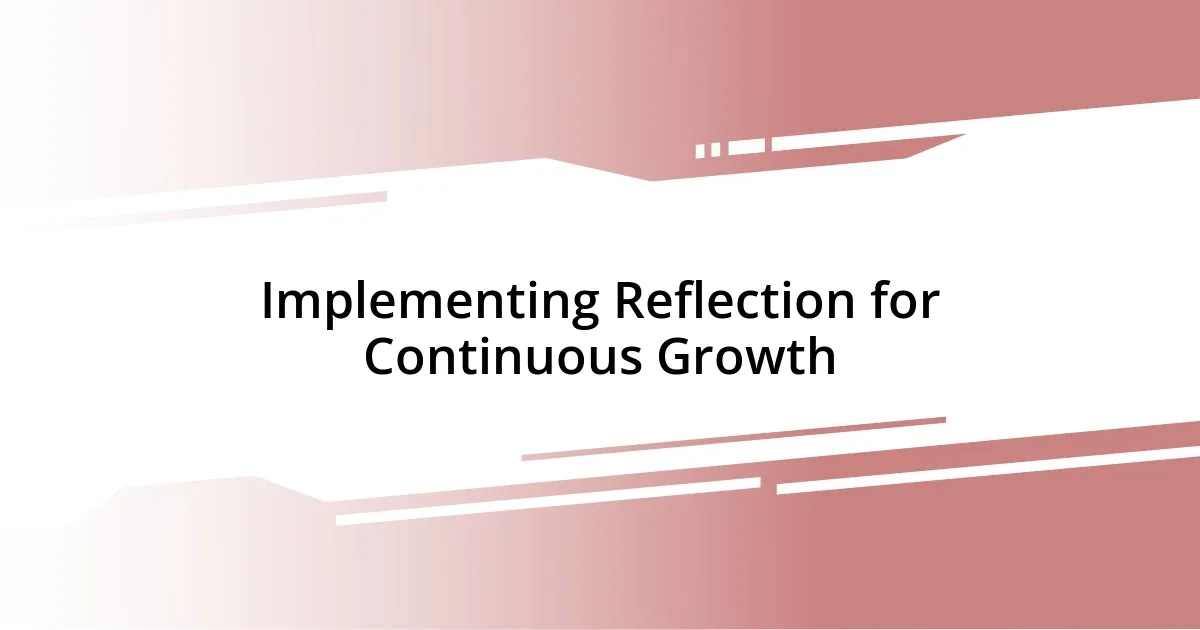Key takeaways:
- Team reflection fosters a culture of continuous improvement, allowing individuals to share experiences and insights, enhancing trust and transparency.
- Structured questioning and rotating facilitators during reflection sessions can unlock diverse perspectives and empower team members, leading to innovative solutions.
- Creating a psychologically safe environment is crucial for encouraging openness and honest sharing, allowing team members to address challenges collectively.
- Measuring the outcomes of reflection through feedback loops and tracking actionable results can provide valuable insights for continuous growth and improvement.

Understanding Team Reflection Importance
Reflection is a powerful tool for teams; it creates a space for individuals to share their experiences and insights. I remember a team meeting where we gathered to discuss a failed project. As we reflected on what went wrong, I felt a palpable shift in the room. Everyone opened up, and instead of placing blame, we collectively explored our roles. Isn’t it amazing how vulnerability can lead to deeper understanding?
When teams take the time to reflect, they foster a culture of continuous improvement. It’s not just about assessing outcomes but also about embracing the journey. I once worked with a group that practiced regular reflection sessions. These moments cultivated trust and transparency among us; we weren’t afraid to admit mistakes or celebrate small wins. Have you ever experienced that sense of camaraderie when a team learns together?
Moreover, team reflection allows for diverse perspectives to emerge, enriching the decision-making process. I’ve seen how varied insights can illuminate blind spots that one or two people might miss. Isn’t that why we come together as a team in the first place? To combine our strengths and grow beyond our individual capabilities? This collaborative reflection can be a game-changer for not only enhancing team dynamics but also driving overall success.

Benefits of Regular Team Reflection
Regular team reflection offers myriad benefits that can enhance both individual and group performance. I recall a time when our team dedicated just a half-hour each week to reflect on ongoing projects. This simple practice created an environment where everyone felt valued and heard. It was eye-opening to see how even small discussions could lead to significant shifts in our strategies and enhance our collaboration.
Moreover, these reflection sessions often acted as a catalyst for innovation. I remember when a team member shared a different perspective during one of our discussions—an idea that initially seemed far-fetched transformed into a pivotal solution for our project. Sharing experiences in a safe space paved the way for creativity. Isn’t it remarkable how a single moment of honest reflection can ignite a wealth of collective intelligence?
Regular team reflection can also significantly improve morale and motivation within the group. During one particularly challenging project, our reflections revealed personal struggles that some team members were facing. By addressing these issues together, we not only supported each other but also strengthened our bond. It’s fascinating how these moments of connection can turn challenges into shared triumphs, transforming the team atmosphere completely.
| Benefit | Description |
|---|---|
| Improved Communication | Encourages open dialogue, fostering trust and transparency. |
| Enhanced Creativity | Promotes sharing diverse ideas, leading to innovative solutions. |
| Increased Engagement | Boosts team morale by addressing personal and professional challenges together. |

Creating a Reflection-Friendly Environment
Creating a reflection-friendly environment begins with establishing psychological safety within the team. I remember a time when we made it a point to create ground rules for our reflection sessions—no judgment allowed. This simple framework made a world of difference. Once, a colleague shared their hesitation on a project, and instead of criticism, we rallied together to brainstorm solutions. That’s when I truly felt the power of a safe space.
To further cultivate this environment, consider implementing the following practices:
- Encourage Openness: Invite team members to share thoughts and emotions without fear of repercussions.
- Set Clear Expectations: Define what members can expect during reflection sessions to enhance comfort.
- Promote Active Listening: Foster a culture where everyone is truly listened to, making contributions feel valued.
- Use Positive Reinforcement: Celebrate moments of vulnerability as strengths, reinforcing that sharing is a sign of courage.
- Follow Up: Demonstrate commitment to addressing insights gained from reflections, showing that conversations lead to action.
Creating this kind of space transforms reflection from a mere task into an enriching experience, deepening connections and driving success.

Techniques for Effective Team Reflection
One effective technique for team reflection that I’ve found invaluable is structured questioning. I once facilitated a session where I asked my team to respond to specific prompts like, “What went well this week?” and, “What challenges did we face?” This approach brought forth insights that might have otherwise gone unvoiced. It’s fascinating how a few targeted questions can pave the way for deeper understanding and connection among team members. Have you experienced that too?
In my experience, rotating the facilitator role can also breathe new life into reflection sessions. The first time a junior team member led our discussion, I was surprised by the fresh perspectives they brought. Their unique view transformed the way we approached our projects. I realized that giving everyone a chance to lead not only empowers individuals but also fosters a culture of inclusivity and shared responsibility. Why not try it with your team?
Lastly, keeping a reflection log can serve as an excellent reference point for teams. I remember when we implemented this practice; it allowed us to track progress and revisit past discussions. It’s almost like having a time capsule of our growth! Imagine how helpful it would be to look back and see how far you’ve come together. With these techniques, I genuinely believe teams can unlock their full potential through meaningful reflection.

Challenges in Team Reflection Processes
When reflecting as a team, one major challenge is ensuring everyone feels comfortable sharing their thoughts. I recall a session where a member hesitated to voice their concerns, fearing it would stir conflict. It’s tough to strike a balance between honesty and harmony. How do we encourage candidness without risking team cohesion? I’ve found that it often takes a few openers—like sharing my own vulnerabilities first—to create that ripple effect of openness.
Another hurdle I’ve noticed is the tendency for discussions to veer off course. I once facilitated a reflection where we started discussing one project and ended up deep-diving into unrelated issues. It was as if we were chasing rabbits! Establishing clear boundaries and sticking to the agenda can be pivotal. Have you faced similar distractions? Keeping a visual reminder of our goals helps refocus the conversation, steering it back to where it needs to be.
Finally, the time constraints of busy schedules can significantly impede reflection practices. I can vividly remember a period when back-to-back meetings left no room for genuine reflection. It felt like we were racing against the clock rather than taking the moments we needed to grow. Why is it we can prioritize task completion but struggle to carve out space for reflection? Allocating even just ten dedicated minutes can transform our mindset, helping us to transition from doing to becoming better!

Measuring Reflection Outcomes in Teams
Measuring the outcomes of team reflection can be a revelatory process. I remember a time when we decided to implement a feedback loop after our reflection sessions. By gathering input on what team members found valuable and how they perceived the discussions, we could gauge our progress and refine our approach. It was eye-opening; hearing the diverse reactions helped us adjust and strengthen our future reflections. Have you ever noticed how the smallest changes can lead to significant improvements?
Another valuable measurement tool I’ve used is tracking actionable outcomes after our reflection discussions. For instance, following a session focused on better communication channels, we actively monitored any enhancements in our project workflow. I was amazed to see how effectively our conversations translated into action. What about your team? Do you have strategies for connecting discussion points to measurable results?
Lastly, qualitative measures, such as sentiment analysis of team engagement, can prove insightful. After a particularly poignant session, I took a moment to gauge the overall morale. I noticed that team members were more enthusiastic during subsequent meetings, which was a clear sign that reflection was improving our dynamics. Feeling this shift inspired me to keep pursuing reflection, highlighting the profound impact it can have. How do you track the emotional shifts within your team?

Implementing Reflection for Continuous Growth
Implementing reflection for continuous growth hinges on creating an environment where team members feel safe to express their thoughts. One time, in a particularly open session, I shared a mistake I made on a project. This vulnerability opened the floodgates; soon, others were sharing their lessons learned too. It’s interesting how that shared space fosters genuine growth—why do we often wait for someone else to go first?
Establishing regular reflection checkpoints can also drive continuous improvement. I remember introducing a bi-weekly reflection practice in my team, and it was a game-changer. Initially, there was some resistance, but over time, those short sessions turned our scattered ideas into collective knowledge. It made me realize that consistency is key—how often do you reflect with your team?
Moreover, I find that documenting reflections is crucial for tracking growth. For instance, after each session, I encouraged everyone to jot down a takeaway and share it. It was surprising how, after a few weeks, those notes began to form a roadmap for our goals and challenges. Isn’t it fascinating how capturing thoughts can serve as a guide for future progress?












